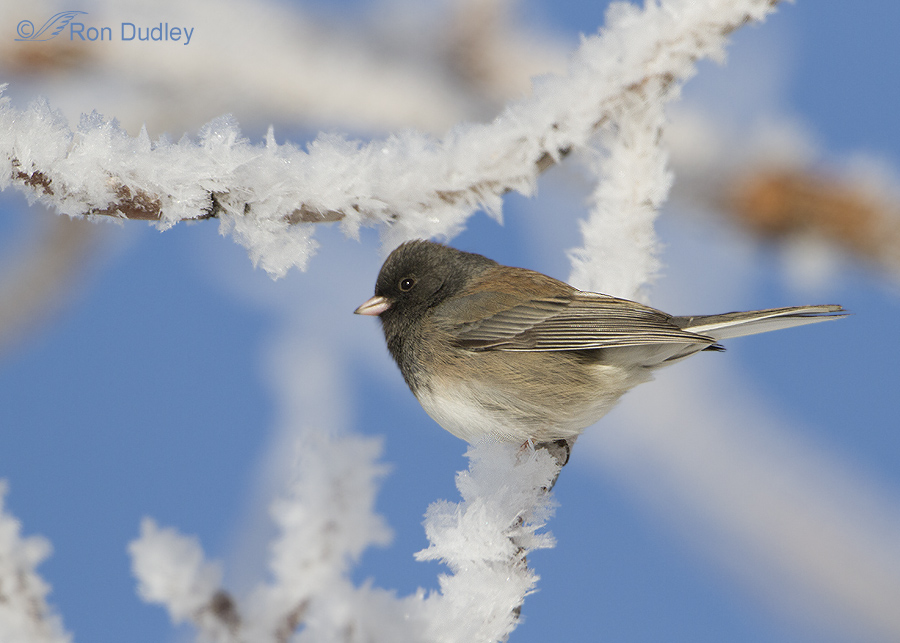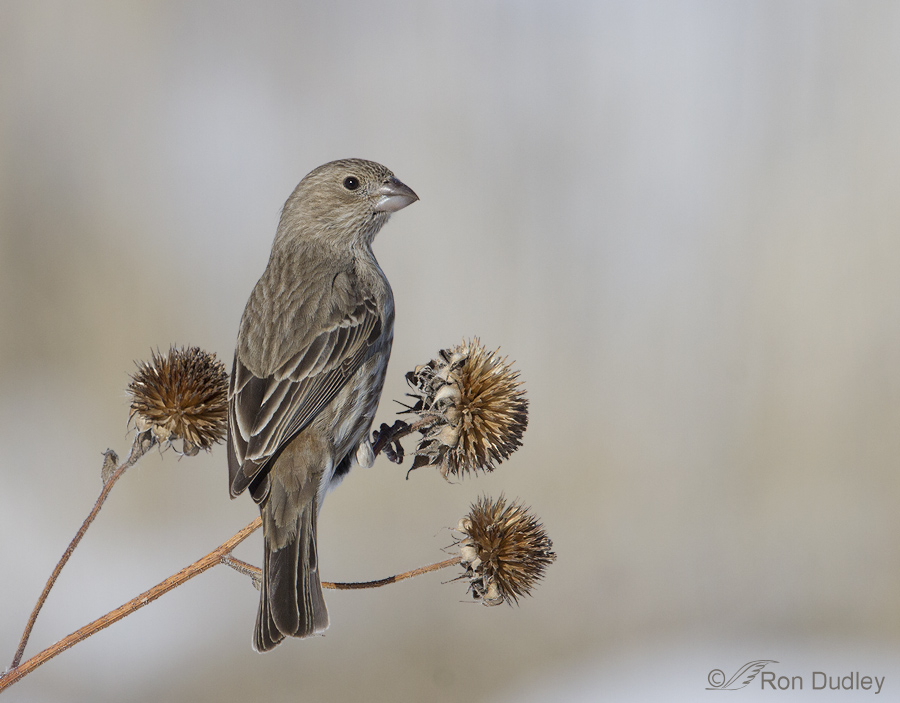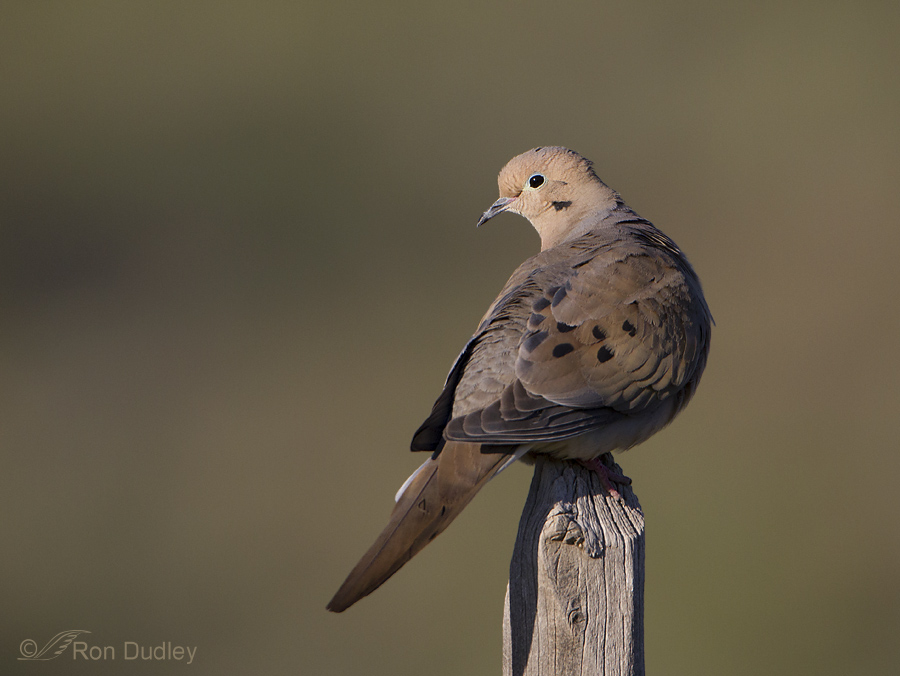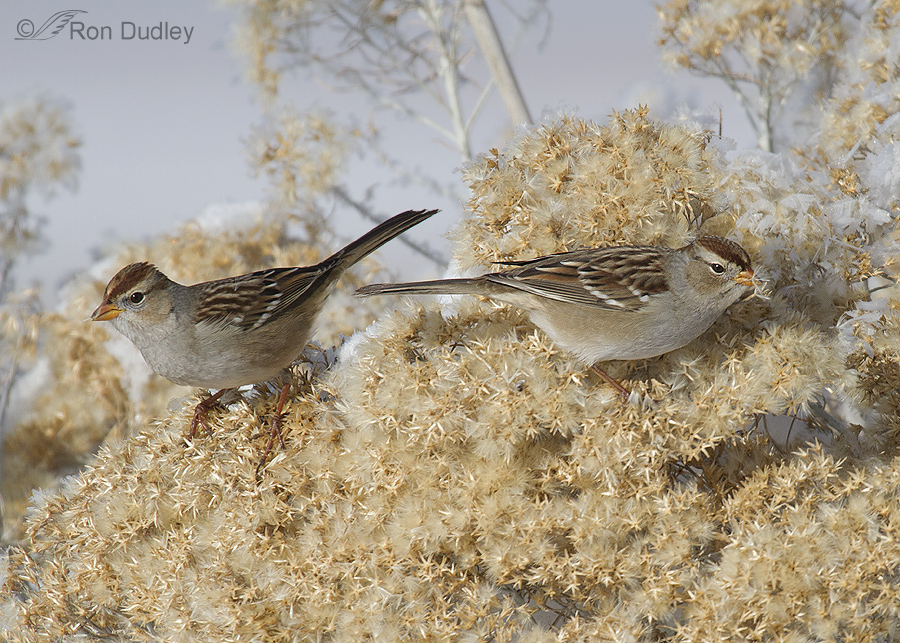Many bird photographers tend to largely ignore the most common species in their areas and I’m as guilty of that as anyone.
There seems to be a sort of “supply and demand” philosophy – the more common they are the less appealing they are as subjects. That’s too bad for at least a couple of reasons – familiar birds can be just as interesting and beautiful as many of the others and what’s “common” where we live and/or shoot is very often uncommon or even nonexistent for folks in other areas. This post is meant to make up to some degree for my own poor judgment at times when choosing subjects.
1/2500, f/7.1, ISO 500, Canon 7D, 500 f/4, 1.4 tc, not baited, set up or called in
Dark-eyed Juncos are quite numerous in northern Utah during winter, especially in the suburbs where they’re often attracted to bird feeders so for valid reason or not I tend to ignore them in my own yard. But occasionally I get an unexpected opportunity with them out in the field. This bird popped up in front of me a month ago at Farmington Bay. I like the heavy hoarfrost in the setting.
1/1600, f/10, ISO 500, Canon 7D, 500 f/4, 1.4 tc, not baited, set up or called in
I also pass on opportunities with House Finches more often than I should. I found this female perched on a dried sunflower stem about a week ago at Lee Kay Ponds. I liked the perch and the monotones so I fired away.
1/2000, f/5.6, ISO 640, Canon 7D, 500 f/4, 1.4 tc, not baited, set up or called in
Yup, I ignore Mourning Doves all too often also. This shot was taken last May at the base of the Stansbury Mountains. I particularly liked the light with this pose.
1/1600, f/8, ISO 400, Canon 7D, 100-400 @ 400mm, not baited, set up or called in
White-crowned Sparrows are found throughout much of North America and though I don’t ignore them as often as I do some of the other common species I’ll often pass them by in my quest for something “more interesting”. That’s a bad habit and I should remember the sage advice of one of my early photography mentors who often said “never leave birds to look for birds” (another take on “A bird in the hand…”, I guess).
These two juveniles were gorging themselves on Antelope Island rabbitbrush seeds a few weeks ago. I call these sparrows a “twofer” species because of the stark contrast in head markings between adults and juveniles (two for the price of one…)
Anyway, I think many of us should consider paying more attention to some of the more familiar species. Their behaviors are just as interesting and like most any species in good light and an attractive setting they can be the subjects of very appealing photographs.
Ron






Very nice photos of all these birds. I used to have Juncos regularly in my yard in the winter when I lived in Richmond, Virginia, and I have to disagree with the description of them as ‘feeder birds’. I have never seen one on a feeder; they are birds that people feed (I was one of them), but they are ground feeders. Here in far west Texas we get Oregon Juncos, who love all the weed seeds in our back yard. No need to buy bird seed for them. I have never met a Junco that I didn’t like.
Your photo of the House Finch really makes her look beautiful.
I think that is a wonderful tribute-thanks.
What a gift to be able to make the “common” appear “uncommonly” spectacular! Very nice, Ron. And as some of your fans have already indicated, common to you is not necessarily common to the rest of us.
It’s true all round the world obviously. I’m hoping to see the first three at the end of the week, so will think of these photos if I do. I really like the one of the ice and the Junco. Now that I think about it, that’s an odd name – do you know where it came from?
Love them all. And no, they are not common in my neck of the woods. Though our sparrows are similar, and everywhere. And still have charm.
Thank you.
I really love all of the photos of these “common” birds. Where I live, that’s all I get to see in the wintertime so common is way better than nothing.
They’re a bit like family photos – you tend to pass them by because the faces are familiar, but when you really look at them, you see something interesting captured in the moment. My favorite is the pair of busy sparrows. Thanks as always, Ron.
The first year my girlfriend and I attended the “Biggest Week in Birding” at Magee Marsh we were viewing some odd looking birds which were all black, with white bills. We wondered aloud what it was, and another birder next to us said “It’s just a coot” and walked away.
We decided we NEVER wanted to have that attitude*.
I still enjoy watching coots. They are very entertaining (and a challenge to photograph).
*Though I refuse to take any more pictures of Turkey Vultures.
Love the composition, contrasts and detail of these familiar little friends…re the hoar frost in the first image: is that what you refer to as “frost flowers”? I love the term, but had never heard it before one your blogs…reminds me of apple or cherry blossoms in spring….which I’m going to pretend it is, because , since I can’t ski, skate or snow shoe any more, I’m already sick of winter…especially one whose temperatures won’t hold steady.
Patty, No – “snow flowers” usually occur on the flat surface ice of ponds when it’s very cold. They start as individual lumps of frost separated from each other by various distances and after that each clump sometimes grows in circles of ever increasing diameters. They’re pretty neat.
The common birds – and these images – are precious. Thanks for paying a little tribute to them.
Thank you, Patricia.
I like all of these images, but I particularly like the Mourning Dove image. It’s exquisite. I’m always ignoring common birds and clearly, it’s my loss.
Sounds like we both need to change our ways, Sharon. Thanks.
Ron- I like all of these images especially the Junco with the hoar frost. Common birds can be very good subjects and are usually much closer for great detail. Good post!
Thank you, Bob. There’s just something about hoarfrost in the setting…
Thanks, Ron. They’re not only great photos re the setting, but the birds have beguiling attitudes and expressions.
I, too, love the subtleties of our common birds. The tufted titmouse, here in New Hampshire, is another favorite of mine. Please do keep sharing your photos of our ‘everyday’ birds!
Yes, that’s one of my points, Alison. Your common Tufted Titmouse is a species I’ve never seen or photographed, though we do get the Juniper Titmouse. Thank you.
Great shots. I would have thought they were taken in my yard!! All of those birds cousins are in my yard with lots of other species. I would have nothing to shoot if I ignored these. Even though I must admit I ignore most times the sparrows since there are so many of them and they keep away northern blue birds.
I’m glad to year that you photograph the common species often, Ellen. I swear I’m going to improve my record in that regard!
I find the doves to be very photogenic. The camera just loves them.